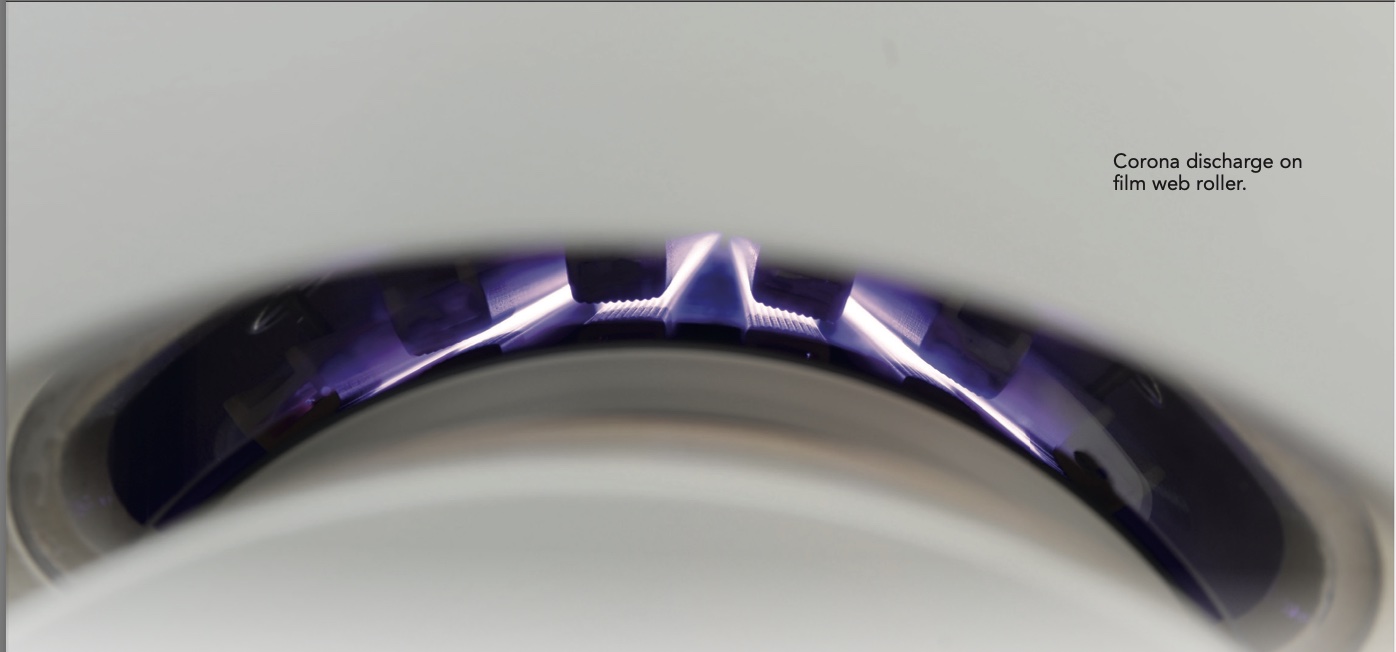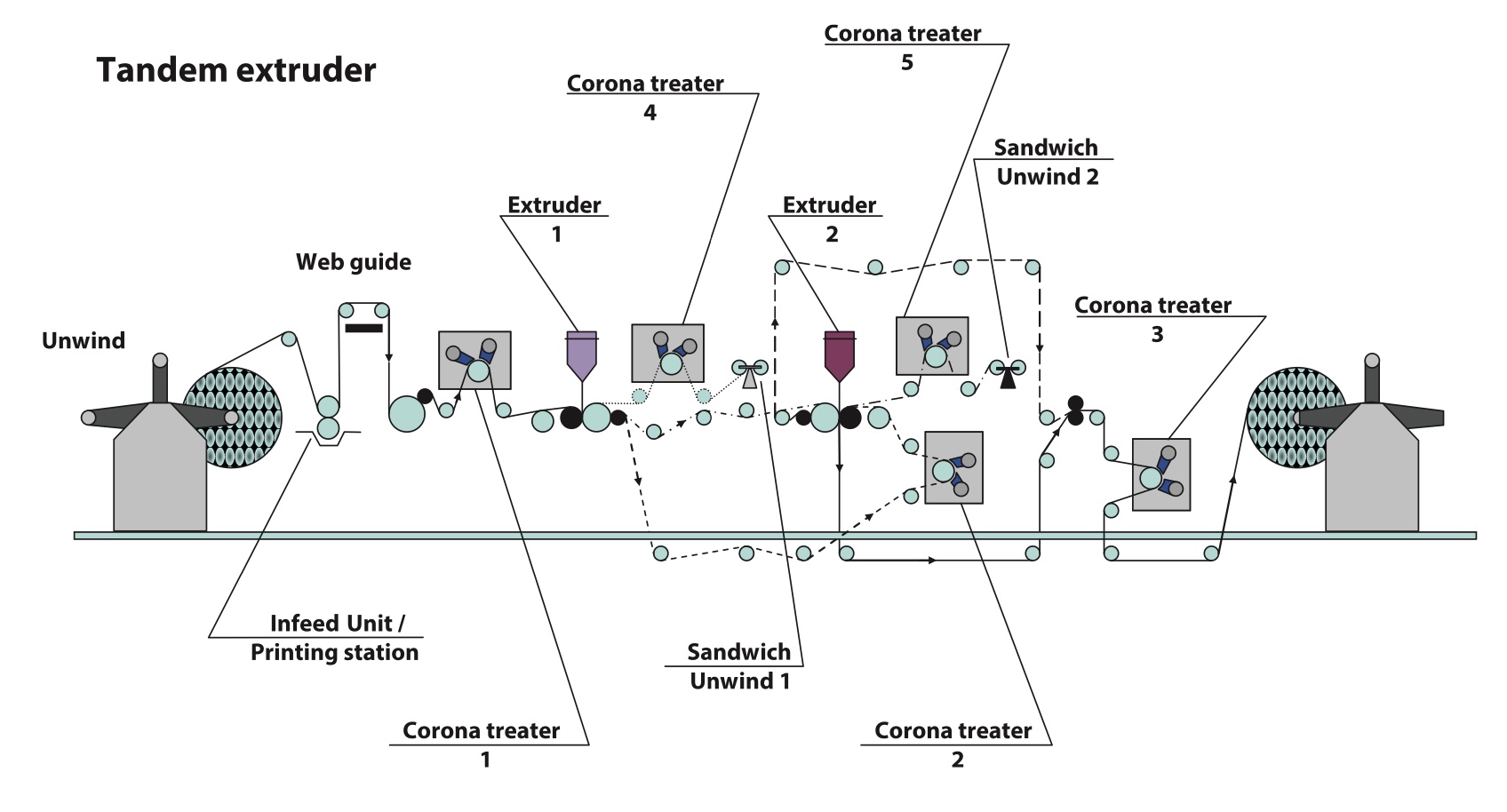Corona Treatment for Extrusion Coating and Laminating Production Lines
- Published: June 19, 2023
By Dr. Frank Förster, Leader of Process Development and Atmospheric Plasma Technology, SOFTAL Corona & Plasma GmbH
Plastic and paper processing companies — especially those converting web materials — are confronted every day with the problems of improving adhesion, quality and increasing the economic efficiency of processing machines. This article illustrates the technology behind corona treatment equipment, how it operates and how it can be applied to the production processes in these companies.
High-frequency corona treatment is widely accepted for improving the adhesion of printing ink, lacquer, glue, coatings on plastic film, paper and metal foil. The controllability and easy handling of corona treatment enable highly reliable and consistent results garnering its success. Over time, the techniques and the effectiveness of the process have been improved to keep pace with the developments of the production machines.

A typical corona treating system consists of a high-voltage electrode and a ground counter electrode. The counter electrode is usually a roller that also guides the treated web. As soon as the applied high voltage reaches the breakdown value in air, an electric discharge between the electrodes occurs. Dielectric coatings on the high-voltage electrode and/or the counter electrode keep the discharge smooth and uniform and avoid transformation into a thermal arc.
The corona treatment effect is based on bombarding the surface of the material with electrons. These leave the electrode and are accelerated under high tension towards the passing material. Subsequently, the electrons collide with air molecules which transmit light and react in part to generate ozone and nitrogen oxide. When the electrons come into contact with polyethylene for instance, they have so much energy that they can break the bond between carbon-hydrogen and carbon-carbon molecules. Reactions with the corona take place at these free radicals, creating oxidation. The functional groups formed are polar and provide the basis for adhesion of applied printing inks, lacquers, etc.
In practice, the surface of aluminum foil, even when annealed, is not free from organic residue. By intensive corona treatment these substances will continue to oxidize and cross-link so that adhesion becomes more certain. The corona “equalizes” the aluminum surface in the machine and transverse directions, and helps to reduce wastage in the case of unevenly annealed foil.
In the case of paper, chemically non-polar fillers and lignin are oxidized by corona treatment. The main component of paper, the cellulose, is hydrophilic due to hydroxyl groups in the aliphatic ring.

Corona generators are used to supply the treating system with high voltage at a frequency between 15-40 kHz. Modern corona generators use a modular design to overcome the limitation of the maximum power per generator or electrode, while significantly increasing the reliability of the system. Characteristic for the generator are several inverter modules connected in parallel, which increases the maximum power of a generator up to 144 kW and so more than doubles power value compared to the standard generators in the market.
Modular generators ensure simple and fast changeover to minimize downtime in the event of failure. Production can even continue with a faulty generator by disabling it at the expense of reduce output power. Dosage can be programmed into the generator which will then automatically set the output power proportionally to the line speed for optimal treatment. With multiple modular generators, power levels can effectively treat very wide and high-speed lines.
The width of web and the speed are a linear function of the power rating — the unit of measurement for specific energy. The formula mentioned below contains the necessary parameters such as generator output P (watts), processing width Treating Width TW (m) and machine speed v (m/min). There the corona dosage D is defined as follows:

In extrusion coating and laminating, base materials are such as paper, cardboard, aluminum foil and plastic film. These are laminated together using plastic melt, or are coated with plastic melt.
All materials of the laminate must be corona treated in-line before coating or laminating to achieve an acceptable degree of laminating strength. In this case, the corona treater is installed as close as possible to the laminator prior to the anchor coating unit.
The processing of materials will depend on the material type and demand of bond strength. In the example case of an LDPE coating, corona treatment is used to improve the bond strength without the need for an anchor coating, thus reducing cost. It may also be necessary to treat the plastic coating, usually LDPE, for further processing. This will determine the type of cooling cylinder used on the laminator based on the power rating.
The key features of the corona treater for extrusion and lamination are:
- Dielectric barrier ceramic electrode and dielectric ceramic coated backing roller prevent perforation of paper. The edges of paper and aluminum foil have high mechanical impact at high web tension/web speed (600 m/min) and so ceramic coating is necessary on backing roller.
- High-voltage ceramic electrodes are cooled and ozone generated in corona discharge is removed via ambient air exhaustion of the electrode housing. In case of paper with its rough surface, where ozone adheres, extra exhaustion is necessary for ozone removal.
- A homogenous surface tension can only be achieved by a speed regulated power control of the generator in order to ensure the same effect at different speeds.
- For extrusion coating/lamination the corona dosage is in the range of 25 to 35 Wmin/m2.
Corona treatment is fundamental to the processing of film materials and vital for good lamination. As demands upon packaging, materials and processing become more complex, it is important to rely upon industry experts to ensure optimum product quality and performance.
About the Author
Frank Förster has been at SOFTAL Corona & Plasma GmbH since 1993. He holds a doctorate in Physics from Clausthal University of Technology in Germany. SOFTAL manufactures corona and plasma-based surface treatment systems for foil, film, paper and web material surfaces for numerous industries. SOFTAL Corona & Plasma is represented in North America by 3DT LLC in Germantown, Wisconsin. 3DT also manufactures a broad range of surface treatment systems, all customizable for unique applications.





